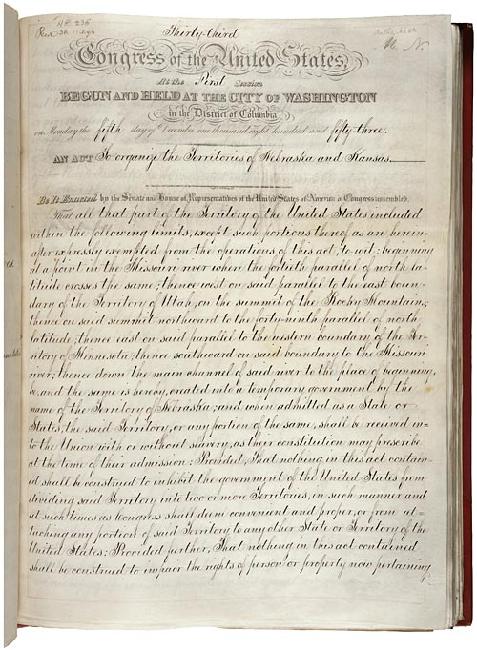About Publications Library Archives
heritagepost.org

Preserving Revolutionary & Civil War History

Preserving Revolutionary & Civil War History

Media type: treaty-image
Annotation: In 1854, a piece of legislation was introduced in Congress that shattered all illusions of sectional peace. The Kansas-Nebraska Act destroyed the Whig Party, divided the Democratic Party, and created the Republican Party. Ironically, the author of this legislation was Senator Stephen A. Douglas, who had pushed the Compromise of 1850 through Congress and who had sworn after its passage that he would never make a speech on the slavery question again. As chairman of the Senate Committee on Territories, Douglas proposed that the area west of Iowa and Missouri–which had been set aside as a permanent Indian reservation–be opened to white settlement. Southern members of Congress demanded that Douglas add a clause specifically repealing the Missouri Compromise, which would have barred slavery from the region. Instead, the status of slavery in the region would be decided by a vote of the region’s settlers. In its final form, Douglas’s bill created two territories, Kansas and Nebraska, and declared that the Missouri Compromise was “inoperative and void.” With solid support from Southern Whigs and Southern Democrats and the votes of half of the Northern Democratic members of Congress, the measure passed. Why did Douglas risk reviving the slavery question? His critics charged that the Illinois Senator’s chief interest was to win the Democratic presidential nomination in 1860 and secure a right of way for a transcontinental railroad that would make Chicago the country’s transportation hub. Douglas’s supporters pictured him as a proponent of western development and a sincere believer in popular sovereignty as a solution to the problem of slavery in the western territories. Douglas had long insisted that the democratic solution to the slavery issue was to allow the people who actually settled a territory to decide whether slavery would be permitted or forbidden. Popular sovereignty, he believed, would allow the nation to “avoid the slavery agitation for all time to come.” In fact, by 1854 the political and economic pressure to organize Kansas and Nebraska had become overwhelming. Midwestern farmers agitated for new land. A southern transcontinental rail route had been completed through the Gadsden Purchase in December 1853, and promoters of a northern railroad route for a viewed territorial organization as essential. Missouri slaveholders, already bordered on two sides by free states, believed that slavery in their state was doomed if they were surrounded by a free territory.
Year: 1854